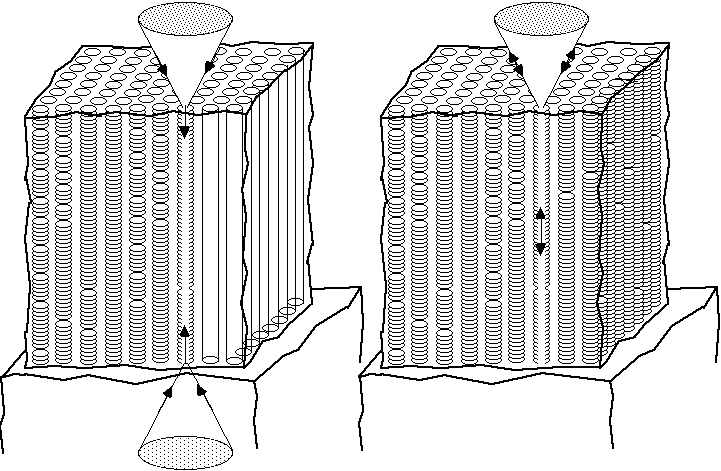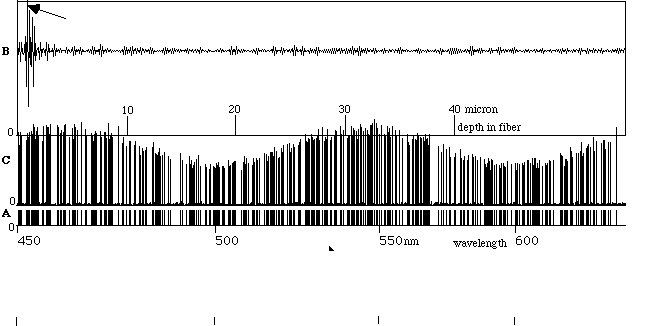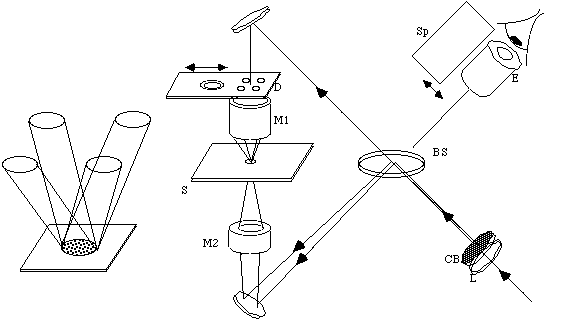1Collège de France et Observatoire de Haute-Provence (CNRS) 04870 Saint-Michel l'Observatoire, France e-mail: labeyrie@obs-hp.fr 2Thomson-CSF, Laboratoire Central de Recherche, 91404 Orsay, France
Tests of optical data storage in arrays of micro-fibers confirm the applicability of the principle and its potential for higher storage densities than achievable with conventional holographic data storage. Arrays of single-mode micro-fibers, spaced 0.78 micron apart and 60 micron long, were generated in a photopolymer film with four laser beams, and simultaneously inscribed with Lippmann-Bragg fringes using a counter-propagating beam. Following the curing steps, spectra of white light retro-reflected from a single fiber exhibit the reconstructed spectral lines of the multi-wavelength laser used in the recording step. 1011 bits/cm2, or 1013 bits on a compact disc, appear recordable.
We have investigated a data recording principle
1
related to the color photography process invented by Gabriel Lippmann
in 1894
2,
but involving a fibered material and spectrally patterned light.
Fig. 1
sketches the ultra-microscopic columnar structure of arrayed micro-fibers
with
data inscribed in the form of a refractive modulation index along their
core. To inscribe the data, one focuses two counter-propagating laser
beams at both ends of a fiber. Their light is guided in the fiber core,
where
their interference generates standing waves. After the exposure and
suitable
processing, the photo-refractive material in the core acquires a grating-like
modulation of its refractive index.
Read-out is achieved with a spot of poly-chromatic light focused at a fiber's entrance by a microscope lens, and which becomes guided in the fiber. Those wavelengths inscribed during the recording exposure are selectively reflected, according to the Lippmann-Bragg effect 3,4, 5,6, 7,8 of constructive interference for vibrations reflected on successive laminae. A "reconstructed spectrum" resembling the spectrum of the exposure light is therefore seen when analyzing spectroscopically the reflected light collected from a single fiber illuminated with white light. It can contain several hundred distinct wavelengths, and may thus serve to encode data with a corresponding number of bits. The recording of an interferogram and reconstruction of the initial spectrum may also be considered as a form of Fourier spectroscopy.
Light focused by a microscope lens at the entrance of an optical fiber can penetrate it and be guided in it if the spot size and numerical aperture match the core size and the angular acceptance of the fiber. The condition allows a core size as small as 0.5 micrometer if the refractive index of the fiber core and cladding differ by 0.05 or more. This is achievable when creating micro-fibers holo-graphically 9 in photopolymers such as DuPont Omnidex, as described below.
Fibers with sub-micron cores ensure single-mode light propagation, and the fundamental Gaussian mode of the guided wave extends outside of the core. It can be diffracted by gratings in the neighbouring fibers, a condition which might cause cross-talk between the signals. The proportion of optical power guided in the fiber can be derived from the field propagation equations in single-mode fibers. It is of the order of 70% with the previously used values, suggesting that the amount of cross-talk remains moderate.
When Bragg gratings are recorded in a fiber, the number of distinct
wavelengths which can be recorded and read-out independantly is limited
by the spectral selectivity achieved in the readout. For weakly modulated
Bragg structures, it amounts to
![]() /
/![]()
![]() = n l / 2
= n l / 2![]() ,
where
,
where ![]() is the wavelength,
is the wavelength,
![]()
![]() the reconstructed line-width, n the refractive index of the medium and
l the fiber length. One of us (AL) wrote a simulation code to investigate
more accurately the signal, the noise and the error rates which it causes
in the data retrieval. It involves a Fourier transformation of the recorded
spectrum to calculate the interferogram, a power law distorsion to
simulate the sensitometric response of the recording medium, and the
addition of noise simulating its granularity. An inverse Fourier transformation
finally gives the reconstructed spectrum. These simulations
(Fig. 2)
indicate that 600 distinct wavelengths can be recorded and
reconstructed in 300 micron long fibers, under conditions providing
a low error rate. They also show that a better signal/noise ratio is
achieved when the recorded wavelengths are spaced like the resonant
modes of an optical cavity having the same optical length nl as the
fibers.
the reconstructed line-width, n the refractive index of the medium and
l the fiber length. One of us (AL) wrote a simulation code to investigate
more accurately the signal, the noise and the error rates which it causes
in the data retrieval. It involves a Fourier transformation of the recorded
spectrum to calculate the interferogram, a power law distorsion to
simulate the sensitometric response of the recording medium, and the
addition of noise simulating its granularity. An inverse Fourier transformation
finally gives the reconstructed spectrum. These simulations
(Fig. 2)
indicate that 600 distinct wavelengths can be recorded and
reconstructed in 300 micron long fibers, under conditions providing
a low error rate. They also show that a better signal/noise ratio is
achieved when the recorded wavelengths are spaced like the resonant
modes of an optical cavity having the same optical length nl as the
fibers.
Such a cavity could conceivably be used in the form of the laser serving
in
the recording step. A micro-laser cavity of optical length nl, containing
a
multitude of electrodes to control the gain profile with
![]() /4n
resolution, can emit a spectrum with the required pattern of multiple
axial
modes, having fixed wavelengths but adjustable intensities
1.
The spectrum of the emitted light is then such that the interferogram
inscribed in
the fiber is identical to the gain profile in the cavity. To analyze
the
reconstructed beam, a modernized version of Lippmann's fine-grain emulsion
is
also feasible in the form of a multi-electrode detector similar to the
laser,
and it would also record a similar signal profile. If the data bits
to be
stored are applied to the laser electrodes, then the interferogram recorded
in
the fiber is an image of the data word, and the same word is also read
by the
detector on its multiple outputs.
/4n
resolution, can emit a spectrum with the required pattern of multiple
axial
modes, having fixed wavelengths but adjustable intensities
1.
The spectrum of the emitted light is then such that the interferogram
inscribed in
the fiber is identical to the gain profile in the cavity. To analyze
the
reconstructed beam, a modernized version of Lippmann's fine-grain emulsion
is
also feasible in the form of a multi-electrode detector similar to the
laser,
and it would also record a similar signal profile. If the data bits
to be
stored are applied to the laser electrodes, then the interferogram recorded
in
the fiber is an image of the data word, and the same word is also read
by the
detector on its multiple outputs.
In ordinary holographic data storage 5,6, where N superposed Bragg stratifications carry data bits, the intensity of the reconstructed beams falls as 1/N2. It severely limits N. The situation is different here, as can be judged from Lippmann's success in reconstructing white-light. The contrasted fringes near the central fringe of the interferogram, with periodic returns at intervals corresponding to the optical length of the laser cavity, reflect light regardless of the number of data bits. Pending a deeper theoretical analysis, our simulations made with various levels of noise do show that the values of N can be larger in fibers than in 3-dimensional media. Higher recording densities can thus be expected.
We have experimentally verified several expected features of data recording
in
micro-fibers with the recording and reconstructing apparatus depicted
in Fig.3.
Similar in some respects to what a real disc recorder/reader could
be, it
allowed the simultaneous recording of micro-fibers and of Bragg gratings
within
them, in a single exposure. Pending the availability of suitable
multi-wavelength lasers
1,
an argon laser provided polychromatic light for inscribing a holographic
photopolymer
10,11
(DuPont Omnidex HRF-750X179). Pieces of the 20-micron thick semi-transparent
Omnidex film were laminated to 1-mm flat glass, with up to 3 layers
providing a 60 micron
thickness. A beam-splitter and two microscope lenses allowed to focus
light on
both sides of the film. One of the lenses provides four collimated beams
converging towards the film . Their interference generates a columnar
pattern
with 0.78 micron period, extending throughout the 20 to 60 microns thickness
of
the recording film. The columnar pattern is made achromatic by arranging
a
wavelength-dependant incidence angle of the four beams, using an object
grid
and spatial filtering.
The second lens projects a smoother and fainter (10 to 100 times) light distribution on the other side of the photopolymer, thus generating low contrast standing-waves within the columns. Pending the availability of more appropriate recording materials, this procedure inscribes all fibers with identical data.
Following exposure and the recommended curing steps, ultra-violet saturation and heating at 120°C for two hours, the Lippmann-Bragg reflection was observed and analyzed spectroscopically. Under the microscope, equipped with a 100X oil-immersion objective, the fiber array was apparent in transmitted and reflected light (Fig. 4a).With a beam-splitter between the microscope objective and the eyepiece, a sub-micron spot of white light could be projected throught the objective onto the entrance of a fiber, and its Lipmann-Bragg reflected light could be observed, in the form of a blue spot. When optimally adjusting the lense's numerical aperture with a diaphragm, the expected confinement of the illuminating light within the fiber could be verified from the fact that most of the blue reflection was observed to return from the same fiber opening, with little straylight around the fiber when the input spot was correctly focused. It indicated that incident white light did penetrate the fiber, deep enough to be reflected and filtered according to the Lippmann-Bragg effect; and that it propagated backward through the fiber entrance with moderate leakage to neighbouring fibers.
Spectroscopic observations of the "blue dot" (Fig. 4b) evidenced the
reconstructed spectrum of the argon laser, although with a lower spectral
resolution than expected from the expression given above for
![]()
![]() .
The discrepancy can arise from imperfect characteristics of the photopolymer
used,
such as absorbtion and scattering. In the field of optical communications,
fibers incorporating Bragg gratings are fabricated with spectral selectivities
beyond 0.1 nm, thus confirming the feasibility of highly selective recording
in
the present case.
.
The discrepancy can arise from imperfect characteristics of the photopolymer
used,
such as absorbtion and scattering. In the field of optical communications,
fibers incorporating Bragg gratings are fabricated with spectral selectivities
beyond 0.1 nm, thus confirming the feasibility of highly selective recording
in
the present case.
Another series of tests has been made with Omnidex film laminated to a mirror, and exposed to four wide beams of monochromatic light, again defining a columnar interference structure striated with uniform standing waves. A subsequent step will be the inscription of different data in neighbouring micro-fibers, as required for real applications. It may require a pre-formed fiber structure with photo-refractive sensitivity in the fiber cores. Alternately, self-trapping effects in polymers such as sensitized polymethyl methacrylate 12, providing a fast index change during the exposure, can also be exploited to generate single fibers with Bragg gratings inside. Various combinations of thermal or photochemical effects, possibly involving multiple pulses and two-photon absorbtion, can indeed be expected to allow the self-trapping and data inscription simultaneously or nearly so. Among the new materials potentially usable for practical recording/reading equipment, those involving nano-particle or molecular magnetism 13 appear of particular interest for rewritable discs.
Multi-electrode lasers and detectors 1 of the kind mentioned above are desirable for fast and efficient access. Arrays of such components may also be considered for parallel writing and read-out of many fibers. With such techniques, a high writing speed appears achievable, so that complete discs be inscribed within minutes. The mass replication of discs is potentially feasible with contact-printing techniques in coherent light, as demonstrated for Lippmann-Bragg holograms 14.
All this shows that data storage with densities beyond 1011 bits/cm2 can be expected with fibered Lippmann-Bragg media. Such density can provide several hours of high-quality, uncompressed, video recording on a single compact disc.
The authors wish to thank A. Delboulbé, V. Laude and C. Joubert (Thomson-CSF) for fruitful discussions.
1. A. Labeyrie, "Laser semi-conducteur et stockage de données sur disque par effet Lippmann", Quinzièmes Journées Nationales d'Optique Guidée, coll. Proc. Palaiseau, 6-8 Nov. 1995.
2. G. Lippmann, J. de Phys., 3ème série, t. III, 97 (1894).
3. Y.N. Denysiuk, Opt. Spectroscopy, 15, 4, 279 (1963).
4. G.W. Stroke and A. Labeyrie, Phys. Letters, 20, 2 (1966).
5. A. Pu and D. Psaltis, Appl. Opt., 35 (14), 2389 (1996).
6. K. Nonaka, J. Appl. Phys. 78 (7), (1995).
7. H.F. Eichler, S. Diez, R. Elschner, R. MacDonald, A. Schellinger, R. Schulz and A. Wappelt, Fourth International Conference on Frontiers of Polymers and Advanced Materials, Cairo (1997).
8. R.J. Collier, C.B. Burckhardt and L.H. Lin, "Optical Holography", Academic Press (1971).
9. A. Labeyrie, "Holo-gratings: the new diffractive breed", Electro-Optical Systems Design, (Feb. 1971).
10. A.M. Weber, W.K. Smothers, T.J. Trout and D.J. Mickish, in Practical holography IV, S. A. Benton, ed., Proc. SPIE 1212, 30 (1990).
11. C. Joubert, B. Loiseaux, A. Delboulbé and J.P. Huignard, in Projection Displays II, Ming H. Wu, ed., Proc. SPIE 2650, 243 (1996).
12. A.S. Kewitsch and A. Yariv, Opt. Lett., 21, 1. (1996).
13. M. Verdaguer, Science, 272, 698 (1996).
14. D. Tipton, M. Armstrong and S. Stevenson, in Practical Holography VIII: Materials and processing, Proc. SPIE 2176, 172 (1994).

Fig. 1. Optical recording (left) and read-out (right) of data in a fibered layer. A transparent substrate (bottom) carries the data layer (middle), 100 to 300 micron thick with optical fibers spaced 0.7 to 1.0 micron apart (the vertical columnar structures). For recording, two counter-propagating beams of polychromatic light are focused at a fiber's ends and guided through the photo-refractive core of the fiber. The interference fringes generate a superposition of phase gratings in the fiber, one for each wavelength used. The gratings, being reflective for the corresponding wavelengths, are probed in reflection during read-out, with a single spot of tunable or broadband laser light.

Fig. 2. Numerical simulation of recording and read-out in a micro-fiber. Light having a random binary spectrum of 600 lines (A) interferes in a 0.3mm-long fiber. Part of the interferogram, to which 1% noise is added, is shown in B with an arrow indicating the central fringe.The spectrum lines being spaced like the axial resonant modes of a cavity having the same optical length as the fibers, the interferogram has a 0.3mm periodicity. In the reconstructed spectrum (C), the low level of noise allows an error-free discrimination of zero and one values.

Fig. 4. (A) Array of micro-fibers, spaced 0.78 micron apart, seen in transmitted white light under the microscope, equipped with a 100X oil-immersion lens. A single fiber is also illuminated in reflection, with a spot of white light, to probe its Lippmann-Bragg stratification. It appears as a brighter dot, blue in color, the spectrum of which (B) matches the recorded argon-laser spectrum (vertical lines). This establishes the occurrence of light confinement and Lippmann-Bragg reflection in a fiber.